No, not all calico cats are female, but the majority are. The calico coat pattern is linked to the X chromosome, and the combination of black and orange colors requires two X chromosomes. Since females have two X chromosomes (XX), they can express both colors, creating the calico pattern. However, male cats have one X and one Y chromosome (XY), so having only one X chromosome limits their ability to display the calico pattern.
Calico
Breed Type: Domestic
Common nicknames: Money Cat
Coat: Short-haired, long-haired
Hypoallergenic: No, they will likely trigger allergies.
Temperament: Friendly, affectionate, sociable, playful
Life expectancy: 12-20 years
Color & patterns: Calico

With their striking coats that blend white, orange, and black patches in a mesmerizing kaleidoscope, Calico cats set the sartorial tone for their fellow cats — like Carrie Bradshaw in the early aughts. Calico is not a specific cat breed but a coat pattern found in various breeds, including American Shorthair, British Shorthair, Persian, and many more. Each breed has their own unique traits and characteristics, but the Calico coat pattern adds an extra dose of visual flair and personality to the cats who sport it. So, whether you have a Calico American Shorthair or a Calico Persian, you can expect an absolutely gorgeous and colorful kitty who will brighten up your life.
Calico characteristics
Learn about about Calico basics like their fur colors, shedding levels, how much grooming they need, and other Calico facts.
Average height
8-12 inches (20.3-30.5cm)
Average weight
6-20 pounds (2.7-9.1 kg)
Average lifespan
12-20 years
Good with other cats
Good with dogs
Affection
Health
Exercise needs
Are calico cats polydactyl?
Yes, calico cats can be polydactyl, but polydactylism is not determined by coat color. Polydactylism can be found in any cat, but it is more predominant in certain breeds, such as the Maine Coon.
Do calico cats have whiskers?
Yes, calico cats have whiskers. Whiskers are important sensory organs that play vital roles in a cat’s spatial awareness and navigation. These specialized hairs are deeply embedded in the cat’s body and are found on various parts, including on the muzzle, above the eyes, and at the back of the front legs.
What color eyes do calico cats have?
Calicos can have amber, green, gold, or blue eyes. The eye color is primarily influenced by a cat’s genetics and breed rather than its calico coat pattern.
What color are calico cats?
Calico cats are white, black, and orange. The black and orange colors can also appear in their diluted versions, creating gray and cream patches. The distribution of these colors varies across each cat’s coat, resulting in a unique and vibrant combination.
When do calico cats stop growing?
Calico cats stop growing and reach their full size between ages one and two. The growth rate varies among individual cats and can be influenced by factors such as genetics, breed, and overall health.
How big do calico cats get?
Calico cats typically weigh between eight and 12 pounds, depending on factors such as genetics, breed, and individual variations. Calico cats can belong to various breeds, each with its own average size range. Healthy diets, regular veterinary care, and enriched environments contribute to their overall well-being.
What is a calico cat?
A calico cat is a breed of cat with a calico coat pattern, meaning the coat is primarily white with black and orange patches (or their diluted variations). The term calico is derived from the colorful, printed calico fabric. The secret to the calico’s distinctive tricolor combination of white, black, and orange is due to genetic variations.
Is calico a breed?
No, calico is not a breed. The calico pattern can be found across various cat breeds.
How long do calico cats live?
Calico cats can live between 12 and 20 years. However, their lifespans vary due to genetics, overall health, and the quality of care they receive. A nutritious diet, regular veterinary check-ups, and a loving environment all contribute to their well-being and longevity.
Are calico cats rare?
No, female calico cats are not rare. However, male calico cats are rare because they require XXY chromosome configurations, which make up a small percentage of calico cats. This anomaly only occurs due to a genetic mutation called Klinefelter’s Syndrome.
What are the different types of calico cats?
The different types of calico cats are classic, dilute, tortoiseshell, and “caliby.” The classic calico has a predominantly white coat with distinct patches of black and orange. Dilute calicos showcase softer shades with gray instead of black and cream instead of orange. The term “caliby” is sometimes used for cats that have a combination of the calico and tabby patterns.
Are calico and tortoiseshell the same?
No, although calico and tortoiseshell cats share similarities, they are not the same. Calico cats have distinctive tricolor patterns with patches of white, black, and orange. Tortoiseshell cats, often referred to as “torties,” feature mixes of black and orange (or their diluted versions) without the prominent white patches seen in calicos.
What does a calico cat symbolize?
Calico cats typically symbolize good fortune and luck, but they have various meanings across cultures. In Japanese folklore, for instance, calicos are symbols of prosperity and are believed to bring financial success and happiness to their pet parents. Additionally, calico cats — viewed as independent and resilient due to their unique, diverse coat patterns — may likewise represent adaptability and strength.
Calico health
Learn about about the Calico health outlook and what diseases they may be prone to at various stages of their life.
What do calico cats eat?
Calico cats should eat high-quality cat food that meets the nutritional requirements for their life stage, whether kitten, adult, or senior cat. Additionally, fresh water should always be accessible to keep them well-hydrated. Individual preferences and dietary sensitivities can vary, so consulting with a veterinarian helps determine the best diet for a calico cat’s specific health needs.
Are calico cats sterile?
No, not all calico cats are sterile. Male calicos are sterile, but females can be fertile. The fertility of female calico cats, like any other cat, depends on their individual reproductive health and not solely on their coat color.
Do calico cats shed?
Yes, calico cats shed. Shedding is a natural part of a cat’s life cycle. The amount they shed varies due to factors such as breed, health, and environmental conditions. Since calico cats may shed moderately, regular grooming (including brushing a few times a week) will help remove loose fur and contribute to a healthier coat.
Do calicos need to be groomed?
Yes, calicos need to be groomed. Long-haired fur can be prone to matting, and grooming prevents tangles, reduces shedding, and helps the overall health of a coat. Brushing a few times a week is beneficial to short-haired cats, too — not only by removing loose hairs but also by providing an opportunity to check for any skin issues, lumps, or abnormalities. It’s also important to trim your calico’s claws and brush their teeth regularly.
Are calico cats hypoallergenic?
No, calico cats are not all hypoallergenic. Hypoallergenic cats produce fewer allergenic proteins in their saliva and skin compared to other cats, but the likelihood of triggering allergies is not determined by their coloration. Calicos, like any other cat, can still produce allergens such as dander, which could cause allergic reactions.
Are calico cats good for allergies?
No, calico cats are not necessarily good for allergies. Some people with allergies may tolerate certain cats better than others, so it’s a good idea to spend time with the cat you’re considering adopting before making the commitment. The color pattern of a calico cat is not a determining factor in allergy management.
Are calico cats healthy?
Yes, calico cats can be healthy. The overall health of a calico cat depends on their genetics, diet, veterinary care, and environmental conditions. Calico cats are not inherently more or less healthy than cats of other colors. But there is one condition that is more likely to affect male calicos:
Klinefelter’s syndrome: Instead of having XY chromosomes, male calicos have XXY chromosomes. This combination often causes Klinefelter’s syndrome, associated with behavioral problems, a propensity for broken bones, increased body fat, and a shorter lifespan. Male calicos can still lead full lives but require additional care to stay healthy.
Calico cats are prone to certain diseases, including:
Dilated cardiomyopathy: Dilated cardiomyopathy is a condition that leads to a decrease in blood pumping to the heart. This causes extra stress on the heart and often leads to Congestive Heart Failure (CHF). Major symptoms include depression, loss of appetite, and weakness.
Hyperthyroidism: This condition occurs when a thyroid produces too many hormones. It can lead to weight loss, excessive thirst, panting, and diarrhea.
Periodontal disease: Periodontal disease is characterized by inflammation and infection of both the gums and the teeth’s supporting structures. It can lead to tooth loss and impact a cat’s overall health. Signs may include bad breath, swollen gums, and difficulty eating.
Chronic kidney disease (CKD): This occurs when the kidneys gradually lose their ability to function properly, impacting the regulation of water, electrolytes, and waste products in the body. Symptoms may include increased thirst, frequent urination, weight loss, and lethargy.
Diabetes: This condition is characterized by the body’s inability to properly regulate blood sugar levels. The metabolic disorder may lead to symptoms such as increased appetite, weight loss, excessive thirst, and frequent urination.
Calico history
Learn about where this Calico came from!
Where do calico cats originate from?
Calico cats are believed to be from the Mediterranean. The gene that determines calico patches correlates to trade routes in coastal Europe and Northern Africa. Today calicos can be found in various breeds and mixed-breed populations worldwide.
Calico temperament
Learn about about the Calico temperament and how well they fit into your lifestyle, home environment, and family.
Do calico cats meow a lot?
Yes, calico cats can meow a lot. Some calicos may be more vocal and expressive, while others are quieter; vocalizations depend on the cat’s temperament, age, and overall disposition. Factors such as socialization, attention, and the presence of other pets can also influence a calico cat’s vocal behavior.
Are calico cats friendly?
Yes, calico cats can be friendly. A cat’s friendliness is influenced by individual temperament, socialization, and past experiences. Many calico cats are known to be affectionate, social, and friendly. However, since personalities can vary, some calicos may be more independent or reserved.
Are calico cats good with other cats?
Yes, calico cats can be good with other cats. Individual disposition plays a big role in their compatibility with other cats. Calico cats may show a range of social behaviors, from being super sociable and friendly to being more independent or territorial. For more successful compatibility, gradually introduce calico cats to other cats, initially provide them with separate spaces, and monitor their interactions.
Do calico cats get along with dogs?
Yes, calico cats can get along with dogs. Compatibility between a calico cat and a dog depends on their personalities, past experiences, and specific temperaments. Positive introductions, allowing each animal to acclimate to the other’s scent, and supervised interactions will contribute to good relationships between calico cats and dogs.
Are calico cats good hunters?
Yes, calico cats can be good hunters. The breed possesses natural hunting instincts that can be honed through play and exploration. While some calicos may excel as skilled hunters, others may display less interest in hunting activities. Giving your cat opportunities for interactive play, such as toys that mimic prey, can help develop and satisfy their hunting instincts.
Are calico cats indoor cats?
Yes, calico cats make great indoor cats. It’s best to keep all cats indoors due to the potential for disease and injury that comes with outdoor living.
Are calico cats good pets?
Yes, calico cats can be good pets. Most calico cats are known for being affectionate, playful, and adaptable to different living environments. However, their personalities can vary, offering potential pet parents a range of temperaments to choose from. As with any pet, providing proper care and attention and meeting their individual needs will contribute to a positive, fulfilling relationship with them.
Are calico cats aggressive?
Calico cats are not typically aggressive. Aggression in cats can be linked to stress, fear, or health issues, so understanding and addressing the root cause is essential. While some calicos may exhibit assertive behavior, many are known for their affectionate and friendly nature.
Are calico cats crazy?
Calicos are cats, which means they’ll probably get the midnight zoomies. Calico cats can be exuberant, especially during play. While some calicos may have more spirited tendencies, others can be laid-back. Give your kitty positive outlets for their energy through interactive play and stimulating environments.
Do calico cats like to cuddle?
Yes, calico cats like to cuddle. Most calicos are known for their affectionate nature and enjoyment of cuddling, but this ultimately depends on the specific personality and experiences of each cat. Some calicos may be more independent or selective in their affections, while others seek out close physical contact with their pet parents.
Do calico cats like water?
Yes, some calico cats like water. Cats have their own reactions to water, which may be influenced by early experiences, genetics, and even individual temperament. It’s advisable to introduce water-related activities gradually and positively.
Find Calico kittens near you
Adopting a Calico
Learn about acquiring a Calico - the pros and cons of adopting versus going through a breeder, and associated costs.
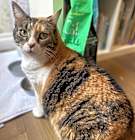
Ava
Calico
Female, 13 yrs 3 mos
Los Angeles, CA
Good with dogs
Good with cats
Spayed or Neutered
Shots are up-to-date
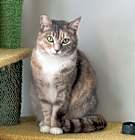
Pickle
Calico
Female, young
Los Angeles, CA
Not good with dogs
Good with cats
Spayed or Neutered
Shots are up-to-date

Stormy
Calico
Female, kitten
Los Angeles, CA
Not good with dogs
Good with cats
House-trained
Spayed or Neutered
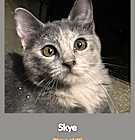
Skye
Calico
Female, kitten
Los Angeles, CA
Not good with dogs
Good with cats
House-trained
Spayed or Neutered
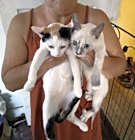
Charlotte
Calico
Female, young
Van Nuys, CA
Not good with dogs
Good with cats
Spayed or Neutered
Shots are up-to-date

Raya
Calico
Female, young
Los Angeles, CA
Good with dogs
Not good with cats
House-trained
Declawed
Spayed or Neutered
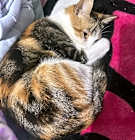
Raya
Calico
Female, young
Los Angeles, CA
Good with dogs
Not good with cats
House-trained
Spayed or Neutered
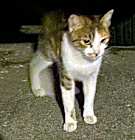
"Christmas" Holly-URGENT
Calico
Female, 4 yrs 3 mos
Los Angeles, CA
Not good with dogs
Not good with cats
Spayed or Neutered
Shots are up-to-date

Ava
Calico
Female, 13 yrs 3 mos
Los Angeles, CA
Good with dogs
Good with cats
Spayed or Neutered
Shots are up-to-date

Pickle
Calico
Female, young
Los Angeles, CA
Not good with dogs
Good with cats
Spayed or Neutered
Shots are up-to-date

Stormy
Calico
Female, kitten
Los Angeles, CA
Not good with dogs
Good with cats
House-trained
Spayed or Neutered

Skye
Calico
Female, kitten
Los Angeles, CA
Not good with dogs
Good with cats
House-trained
Spayed or Neutered

Charlotte
Calico
Female, young
Van Nuys, CA
Not good with dogs
Good with cats
Spayed or Neutered
Shots are up-to-date

Raya
Calico
Female, young
Los Angeles, CA
Good with dogs
Not good with cats
House-trained
Declawed
Spayed or Neutered
